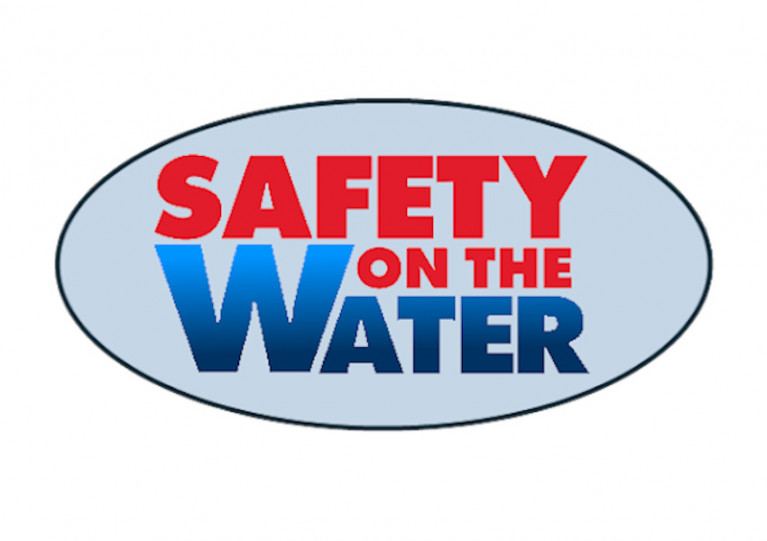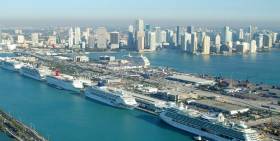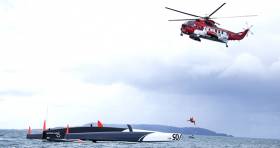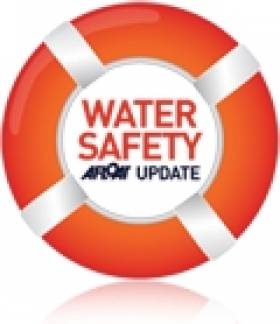Displaying items by tag: Safety on the Water
Lough Neagh Rescue Warns Over Dangers of Jumping Through Frozen Ice
Extremely low temperatures in Northern Ireland (it was -10.5 degrees in Katesbridge in County Down) caused many waterways and lakes and even Bangor Harbour on Belfast Lough to ice over.
Lough Neagh Rescue has reported that it received many calls and messages from members of the public about walking on the Long Ponds in Antrim Castle Gardens in Antrim town. There were also reports of swimmers jumping into Lough Neagh through frozen ice.
Lough Neagh Rescue say "Whilst we can't tell anyone what to do, we would encourage our followers to keep safe and follow current safety guidelines. It might look like fun and you might think it's safe to walk or swim under the ice, but the consequences of your actions could be severe and life-threatening".
More on: Water Safety Ireland Issue Ice Safety Warning for Parents to Risk of Drowning
Before you take part in any water-based activity this summer, or any time of year, you should consider what you need to do in order to stay safe while on or near the water.
Depending on whether you are actually going to be on the sea, on a lake, or near water, such as at the coast, your water safety needs will be different in each case.
The Safety on the Water website gives useful advice and checklists for what to consider when you are going afloat or to the coast.
That also includes advice for watersports, which are an increasingly popular pastime in Ireland. Getting the right training in your watersport of choice is the best start to staying safe afloat.
The website has links to the appropriate national governing bodies to help you find the training you need. Get trained, be safe and have fun!
For more see www.safetyonthewater.ie
There have been a number of warnings about seamanship and navigational issues in the past few weeks that are important as the sailing season draws nearer. I wonder if the boating community takes enough notice of them?
Gail McAllister, who ran the recent successful Irish Sailing’s Cruising Conference has asked sailors to complete a survey about “pot line incidents” and she suggests sharing the information with fishermen. Including fishermen is a good move, because often sailors and fishermen seem to be in a sort of ‘distant’ stand-offishness rather than co-operation and that can and has inculcated disagreement when we are all mariners, even if they are professional and the majority of us boaters are leisure.
Inshore fishing is a tough occupation and fishermen don’t want pots wrapped around yachts or motorboats. The better ones mark their pots – it makes for easier collection. I’m not saying all fishermen are angels and there are unmarked pots, but some of these may and could be put down by ‘leisure potters’ – often not particularly liked by the pro fishermen- and can be unmarked… And some of those “leisure potters” are “leisure boaters” – as some fishermen are ‘leisure sailors’ – so a bit more thought and co-operation around would help us all in the maritime community….
The changes proposed at the Fastnet also drew my attention, as Irish Lights announced structural works and the reduction of the visual distance, the range of the light, from 27 to 18 nautical miles with the installation of a LED lantern. I’m never sure about any reduction in a navigational aid, but the shipping industry which pays for the navigational aids, which we leisure people don’t, doesn’t need these aids as much as we do….and most coastal boating doesn’t range out that far…. But, as when Irish Lights ended the fog signals, I’m always left wondering, though understanding the reasons put forward, reducing the need for diesel generators and removing mercury from the lighthouse while the structural works are needed to the granite tower and Irish Lights understand that Fastnet is important, not only as an Aid to Navigation, but as part of the heritage of the area and as a tourism asset.
Michael Kingston, the well-known international maritime lawyer from Goleen in West Cork who is a Lloyds Lawyer of the Year, has written to Irish Lights, the Taoiseach and a rake of other Ministers and maritime organisations, calling for more State funding for the Fastnet, with a reminder that seafarers cannot just rely on information technology for navigation and need visual aids as well.
And on the subject of LED lights, the Maritime Advisory Board in the UK has questioned why insurance companies allow cruise ships designs where various colour deck lighting aboard them, for passenger benefits, can obscure navigational lights of those vessels or make them confusing to see. That follows a complaint to the British maritime organisation, CHIRP, by a yacht Skipper after an encounter with a cruise ship and with many more in Irish waters, it’s certainly a safety issue.
So is the Volvo Race investigation into racing at night in areas of high vessel traffic density, following the death in Hong Kong in the collision between Vestas 11th Hour Racing and a non-racing boat.
There can be no quibble about safety issues and we can all learn more about safety on the water.
- • Listen to the Podcast below
It's now prime boating time in Ireland with long evenings and warm weather for enthusiasts to re–engage with their passion. It is timely that we share some thought-provoking facts in advance of this period of increased boating activity in the hope of cultivating safer on water behaviours amongst all recreational craft users writes Tom Nallen of insurers Allianz.
As our evenings lengthen and weather improves, boating enthusiasts are re-engaging with their passion. It is timely that we share some thought-provoking facts in advance of this period of increased boating activity in the hope of cultivating safer on water behaviours amongst all recreational craft users.
At Allianz Ireland, our claims statistics support what many already suspect; vessel operator error is the greatest cause of incidents. These include groundings and poor navigation due to inadequate crew training, resulting in collisions with other vessels or objects to name but a few. Over 50% of our claims involve vessel operator error of one kind or another resulting in personal injury, damage to the craft or other property. One can only surmise that many of the incidents are potentially avoidable.
Our customers in Ireland are not unique. Our international colleagues at Allianz Global Corporate Speciality, report losses attributable to vessel operator error that largely mirror our local experience.
The fatality figures linked to pleasure craft are particularly stark. Irish maritime fatality statistics indicate 49% of all marine fatalities are associated with recreational craft use. [1] The principal causes identified by the Marine Casualty Investigation Board are noted below in order of significance.
- Failure to plan journeys safely, including failure to take sea/weather conditions into account.
- Not wearing a personal flotation device (lifejacket/buoyancy aid).
- Lack of crew training.
- Unsuitable or inadequately maintained safety equipment on board, or lack thereof.
- Inadequate crewing levels/solo operation.
- Vessel unseaworthy, unstable and/or overloaded.
- Impairment due to fatigue or the influence of alcohol and/or drugs.
- Inadequate enforcement of regulations.
- Unsuitable clothing being worn on board.
In response to these factors we would suggest the following preventative tips
· Plan all voyages, even where they are short and familiar, taking the weather conditions into account. Ensure contingency plans are considered around items such as back up fuel supply, crew injury or indeed places where refuge may be taken should conditions deteriorate. Log a traffic report with the coast guard or let a responsible person ashore know your route, estimated time of departure and arrival, who is on board and what to do if that time of arrival lapses.
· Ensure that appropriate personal floatation devices are at hand as they can vary depending on the craft type. Check that it is correct in size and operationally fit for use. They should be frequently inspected for wear or tear least it impact their effectiveness. Replace if in any doubt.
· Not all pleasure craft require crew. Whether single handed or crew operated, those on board should be competent, know their role, be familiar with the craft, its equipment, its limitations and its safety equipment.
· All safety equipment (e.g. Fire fighting blanket, extinguisher etc.) should be fit for the craft & its intended purpose. They must be inspected, tested and maintained in line with the manufacturer’s guidance. If gas/LPG (Liquid Petroleum Gas) appliances are on board they should be serviced by an approved party. Should carbon monoxide alarms be present in accommodation areas they should be regularly tested. Basic items such as an operational torch should be considered.
At year end 2015, approximately 64% of all Irish Coast Guard call outs relating to vessels were linked to recreational craft use*. This amounted to 415 distress/emergency calls. In contrast to commercial vessels, there is a rising trend in incidents involving recreational craft, which can in part be attributed to prolonged periods of good weather coupled with an increasing amount of people participating in water based activities. Encouraging a culture that promotes responsible behaviour amongst pleasure craft users in their communities and organisations can go a long way to reduce incident levels.
The Irish Maritime Administration’s Code of Practice for the Safe Operation of Recreational Craft (refer to www.dttas.ie and www.safetyonthewater.ie) provides practical information and gives safety advice on best practice to operators and owners of recreational craft. At Allianz, we strongly recommend all pleasure craft owners and those operating pleasure craft at anytime of the year review the code of practice before taking to the water.
By Tom Nallen, Associate Director of Commercial Sales, Allianz p.l.c
Information correct as of June 2016
* Information sourced from Irish Coast Guard statistics
This article contains guidance notes on general boat safety, no liability is assumed by Allianz by reason of this guidance.
[1] Based on Marine Casualty investigation Board reports and Irish Coast Guard Annual Statistics, 2002-2013 combined.
More from Allianz on boat insurance and boat safety
#safetyonthewater – The Irish Maritime Administration (IMA), the Government's new wing to deal with maritime affairs, is inviting submissions from all interested parties on the new Maritime Safety Strategy, Sea Change – Building a New Maritime Safety Culture, which is currently being developed.
The IMA says the new Maritime Safety Strategy will focus on building a culture of safety and will target the main causes of casualties in the maritime sector.
Minister for Transport, Tourism & Sport Leo Varadkar will formally launch the consultation process this morning at the Coast Guard building at the Department of Transport, Tourism & Sport on Leeson Lane.
It will cover all types of craft being used for any purpose on Irish coastal or inland waters, including recreational craft, fishing vessels, passenger vessels and cargo vessels.
Significantly, it has a focus on recreational craft given the spike in call outs over the past few summers.
The public consultation document, which provides an outline of the key issues, is available on the Department’s website or by telephoning 01-6783454.
The IMA says that submissions received will not be responded to on an individual basis, but they will be taken into consideration by the IMA in the preparation of the new Maritime Safety Strategy. Copies of all submissions received will also be published in full on the Department’s website.
Written submissions should sent by email to [email protected] or by post to the address below by Friday 29th August 2014 at the latest to Maritime Safety Strategy Consultation, Maritime Services Division, Irish Maritime Administration (IMA), Department of Transport, Tourism and Sport, Leeson Lane, Dublin 2
What to Do when Fire Breaks Out Onboard a Vessel?
The accident has been a reminder to all boat owners of the need to carry out regular fire drills and the need for regular maintenance checks on all electrical installations. It has led to a number of requests for advice from readers about what to do in the event of a fire onboard.
Here are a few items from the various publications taken from the Marine Safety Working Group's "Safety on the Water" website which might prove a useful start:
From the Motor boating Sea Safety Guidelines:
If you have a fire on board:
* Rig a sea anchor/drogue so that smoke and flames blow clear of the boat.
Rig it from stern or stem, whichever is appropriate.
* Do not enter any smoke filled space. Try not to breathe in any smoke, as it may be poisonous.
* Put on your lifejackets.
* Get everyone on deck and take all the fire extinguishers with you.
* Try to extinguish the fire where possible. Use a fire blanket to smother
small fires. When using a fire extinguisher, try to hold it upright.
* Fire requires oxygen. Reduce supply of air by sealing vents and hatches. If there is smoke coming from the engine compartment, only open the access hatch enough to insert the nozzle of the fire extinguisher.
* Notify the emergency services.
* Move both the crew and the liferaft as far as possible from the seat of the fire.
* Fitting a fire access port to the engine compartment offers the greatest safety."
From the Power boating Sea Safety Guidelines:
If you have a fire on board:
* Try not to breathe in smoke which may be poisonous.
* Try to extinguish the fire where possible.
* Fire requires oxygen. If there is smoke coming from the engine compartment, or from under the engine cover, only open the cover enough to insert the nozzle of the fire extinguisher.
* Get everyone away from the fire and ready to abandon the vessel, wearing
lifejackets or buoyancy aids.
* Notify the emergency services."


































































